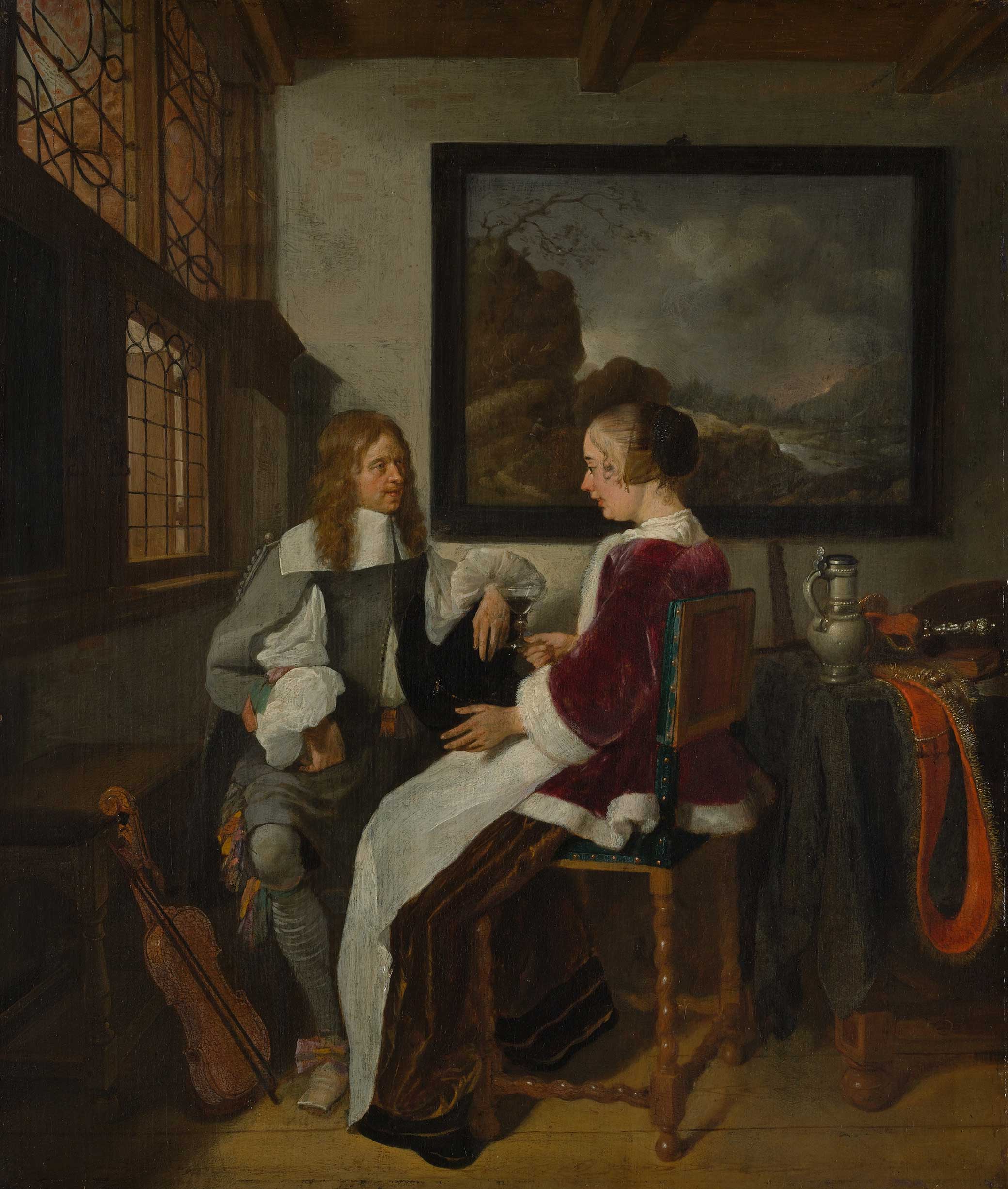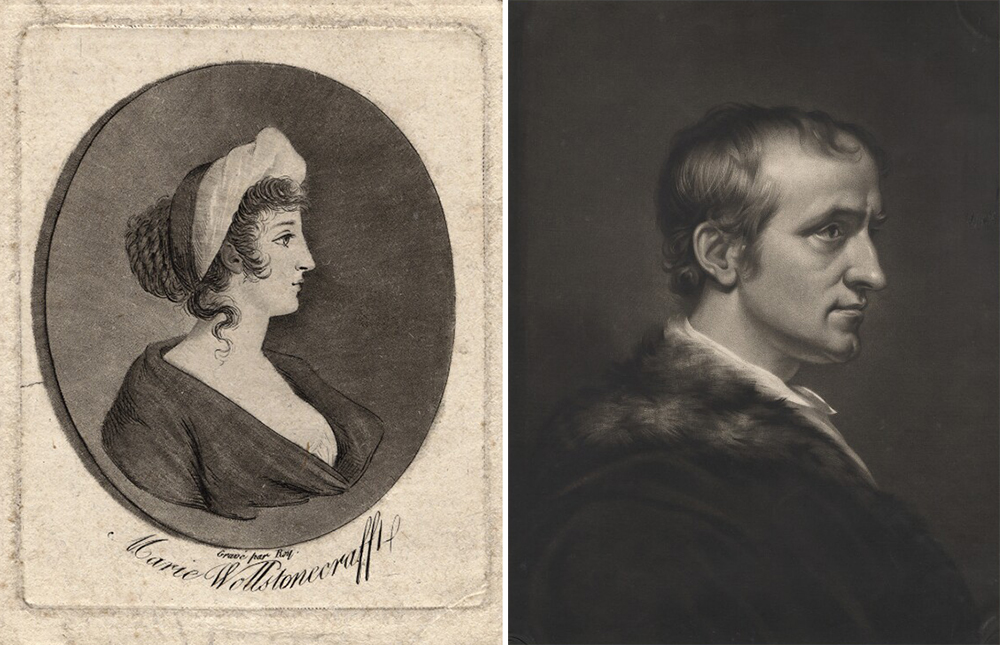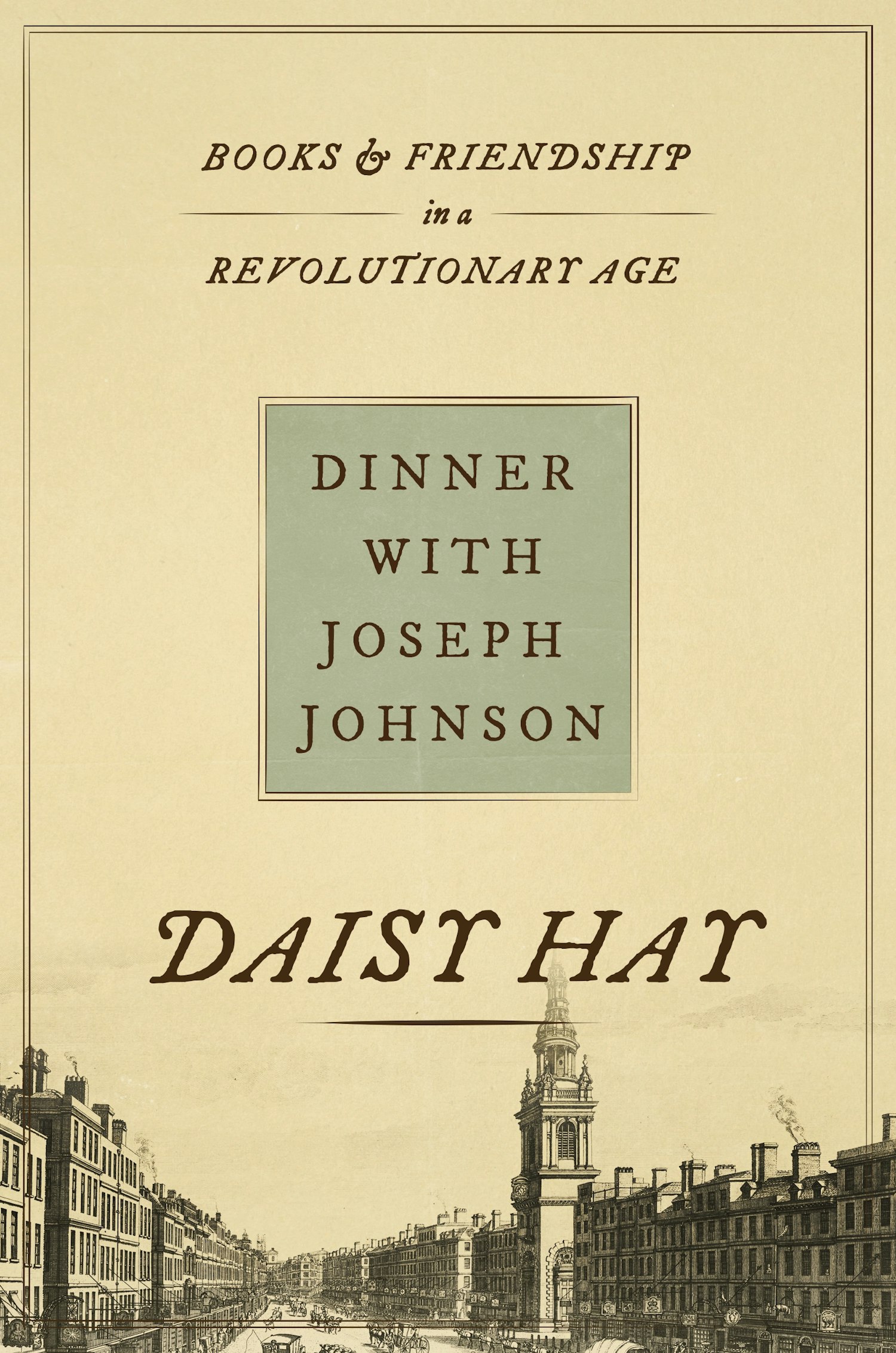
Sentimental Conversation, by Quirijn van Brekelenkam, c. 1660. The Metropolitan Museum of Art, Friedsam Collection, bequest of Michael Friedsam, 1931.
As she looked to the future Mary Wollstonecraft made a determined effort to take control of her own story. She asked her lover Gilbert Imlay to return all her letters and he did so. She made the same request to Henry Fuseli but he refused. She began to work again, commissioning reviews for the Analytical Review on behalf of her publisher, Joseph Johnson. In a series of letters she bade Imlay farewell. She also took the correspondence she had written from Scandinavia and, with Johnson’s support, turned it into a book. She called it Letters Written During a Short Residence in Sweden, Norway, and Denmark, and although in her revisions she blurred personal details and turned her gaze outward to the landscapes and customs of the countries she visited, she also left a carefully mediated version of personal unhappiness. Johnson published the book early in 1796, alongside a new edition of A Vindication of the Rights of Woman. The reviews of Letters were admiring. “If ever there was a book calculated to make a man in love with its author,” wrote William Godwin, “this appears to me to be the book.”
Godwin’s diary for the summer of 1796 records a pattern of meetings as he and Wollstonecraft took tea together, met each other’s friends, visited each other for supper after the day’s work was done, and bumped into each other at the houses of others. The first letter between them dated from July and was from Wollstonecraft. She enclosed with it a gift of the last volume of Rousseau’s Julie; ou, La Nouvelle Héloïse, a novel famous for its revolutionary exploration of female emotional and sexual experience. She sent Julie, she explained, in order to encourage Godwin “not to choose the easiest task, my perfections, but to dwell on your own feelings—that is to say, give me a bird’s-eye view of your heart.”
This instruction set the tone for a courtship correspondence that at times had the rapier wit of Shakespeare’s Beatrice and Benedict and was at other points challenging, combative, affectionate, and melancholy. Wollstonecraft was thirty-six in 1796; Godwin forty. Wollstonecraft had confronted the possibility of being broken by her passions and had rebuilt her life in the face of pain. Godwin believed himself to be immune to the tumults and desires experienced by more susceptible men. Each knew the other to be a brilliant thinker and writer, with a public name and reputation. As they sparred their way to an understanding they treated each other as equals with independent intellects and unknown emotional hinterlands. When Wollstonecraft challenged Godwin to write of his feelings he poked fun at his own emotional reserve and her desire for self-expression, but he did not dissemble. “Shall I write a love letter? May Lucifer fly away with me if I do! No, when I make love, it shall be with the eloquent tones of my voice, with dying accents, with speaking glances (through the glass of my spectacles), with all the witching of that irresistible, universal passion.” In late July it was Godwin’s turn to be absent from London, and Wollstonecraft found herself missing him. “I suppose you mean to drink tea with me one of these days,” she wrote at the beginning of August. “How can you find it in your heart to let me pass so many evenings alone.”
She had written laments of abandonment before, to Imlay, but her mock chastisement of Godwin demonstrated new confidence in the strength of the connection they were forging. She sent him the manuscript of the self-revealing novel on which she was working. It was provisionally titled The Wrongs of Woman, and he read it with care. On August 15 he made a note in his diary: “chez moi.” The phrase, alongside its companion note, “chez elle,” was shorthand for the fact that Wollstonecraft and Godwin had spent the night together. It appeared in his diary with regularity thereafter. Sometimes he appended a gesture toward description. On August 21: “chez moi, toute.” At other points punctuation did the job of expressing the inexpressible: “chez elle, —”; “chez moi, —.” They were “chez elle” more often than “chez moi,” in recognition of the difficulty of leaving Fanny, Wollstonecraft’s two-year-old daughter with Imlay, in the company of only her nursemaid.
The day after their first night together there was a difficult exchange of letters. Both found it easier to communicate on paper than in person, and both acknowledged as much. Godwin had talked of roses growing in the path of every life and encouraged Wollstonecraft to embrace happiness: “I catch at them,” she responded, “but only encounter the thorns.” At the outset of their correspondence she had asked him to describe his own feelings and, after years of rigorous self-containment, he reciprocated with an effusion of emotion she found alarming, even self-indulgent. “Full of your own feelings, little as I comprehend them, you forgot mine—or do not understand my character.”
The pain she had suffered, first over Fuseli and then over Imlay, made her cautious of becoming again the object of transient male passion. As August came to an end the tumults of high summer gave way to a more settled understanding. Their notes took on a patina of domesticity, as they exchanged work and made plans about where to meet, eat, and sleep. Godwin sent fond messages and tiny presents to Fanny, who took to calling him “Man.” When the weather turned stormy Wollstonecraft preferred to stay at home and dine with him by her own fireside, while Fanny slumbered nearby. Sometimes it was still easier to express emotions on paper. In September she reminded Godwin that her relationship with Imlay had produced a dependent child and required her to earn a living by her writing. Godwin had offered a critical response to work in draft, and she read his criticisms as a threat to her ability to keep body and soul together. In an uncharacteristically sharp attack on the two men whose friendship she most valued, she intimated that both he and Johnson had underestimated her talent and her worth. But her rediscovered confidence meant that such difficulties were surmountable. While she was out walking with Fanny the child demanded they pay a call on Godwin. “Go this way Mama, me wants to see Man.” Wollstonecraft related Fanny’s plea to Godwin with pleasure at the unconventional family unit they were forming.

Throughout the winter of 1796–97 Wollstonecraft and Godwin continued in the pattern established that autumn. They exchanged frequent evening and nightly visits and letters to clear up misunderstandings; they moved forward with lives lived together but also apart. Both continued to dine with Johnson, sometimes on the same evening but often when the other was elsewhere. They were cautious about revealing their romance; distant acquaintances assumed that Wollstonecraft was married to Imlay, and she was wary of their censoriousness.
She kept working, organizing Analytical reviews for Johnson and visiting Bedlam in the company of him and Godwin in order to undertake research for her new novel. She went to the theater with Godwin and endured a visit from her sister Everina. In early February she called on Johnson’s old friend Dr. George Fordyce. There is some suggestion in her letters for this period that she and Godwin had been attempting to use a form of rhythm-based birth control. At the end of January, shortly before she called on Fordyce, she realized that this system had failed. “Women are certainly great fools; but nature made them so. I have not time, or paper, else I could draw an inference not very illustrative of your chance-medley system.” The prospect of another pregnancy without the protection of marriage offered little comfort, but she faced its reality head-on. “I spare the moth-like opinion,” she told Godwin. “There is room enough in the world.”
Pregnancy introduced an uncertainty into Wollstonecraft’s future that for a while she resisted. Sometimes she asked Godwin to take on some of her work for the Analytical. “There is a good boy write me a review of Vaurien.” She delighted in the blossoming affection between Godwin and Fanny, but she was an experienced parent and she warned him against overindulgence. “Do not give Fanny a cake today,” she reminded in him March. “I am afraid she stayed too long with you yesterday.”
At the end of March Johnson himself became a source of strain. He pressed her for work and was less prepared than usual to settle her family’s debts. “Johnson is either half ruined by the present public circumstances, or grown strangely mean, at any rate he torments me.” The financial arrangements between Johnson and Wollstonecraft were labyrinthine in their complexity, and details of their transactions have not survived. He sustained her existence, but she never felt free of debt or obligation and, in the early stages of an unexpected pregnancy, the extent of her entanglements increased her sense of vulnerability.
Six days after Wollstonecraft wrote of Johnson’s meanness Godwin made a note in his diary: “Panc.” The word signified his marriage to Wollstonecraft at St. Pancras Church on March 29, 1797. They married as a result of her pregnancy and because she knew too well the difficulties entailed in raising a child outside wedlock. The wedding revealed to casual observers that her marriage to Imlay had been a fiction. Although she moved with Fanny into Godwin’s house in Somers Town after the wedding, she and Godwin agreed to maintain separate working spaces, and he accordingly rented a study in lodgings nearby. During the day they thus continued to correspond by letter.
Godwin attempted to consolidate her debts, many of which she had incurred as a result of her entanglement with Imlay. She and Godwin continued to experience periods of misunderstanding and difficulty and they wrote frankly of the moments when they had failed or disappointed each other. In June Godwin set off on a tour of the Midlands, and during his absence the correspondence between them stretched out once more.
His letters were full of new scenes and new people, interspersed with affectionate messages for Fanny and enquiries after their unborn baby, who they called William (both were convinced that the child would be a boy). To Wollstonecraft herself he sent messages of love and sympathy for the discomforts of pregnancy. “I remember at every moment all the accidents to which your condition subjects you, & wish I knew of some sympathy that could inform me from moment to moment, how you do, & how you feel.” He had promised Fanny to bring her a present from Wedgwood’s factory at Etruria and on June 7 he sent a message that he had not forgotten his vow. “Remember William; but (most of all) take care of yourself. Tell Fanny, I am safely arrived in the land of mugs.”
In Godwin’s absence Wollstonecraft’s attention turned inward. She was now six months pregnant and the physical experience of carrying a second child was at times all-encompassing. “I was not quite well the day after you left me,” she wrote on June 6. “But it is past, and I am well and tranquil, excepting the disturbance produced by Master William’s joy, who took it in his head to frisk a little at being informed of your remembrance. I begin to love this little creature, and to anticipate his birth as a fresh twist to a knot, which I do not wish to untie.” Godwin’s journey home took longer than he had anticipated, and on June 19 she wrote crossly that she had sat up until midnight waiting for him to appear. After his return they resumed their pattern of dining out together and alone, but at the end of June Wollstonecraft confessed that she felt a prisoner of her changing body.
On August 30, 1797, Wollstonecraft sent a note to Godwin to tell him she was in labor. The midwife had been sent for, and Wollstonecraft was confident of a speedy delivery. “I have no doubt of seeing the animal today.” In the meantime, she was bored. “I wish I had a novel, or some book of sheer amusement, to excite curiosity, and while away the time—have you anything of the kind?” The midwife arrived and was sure that the baby was on its way although “she thinks I shall not immediately be freed from my load.” A short time later Wollstonecraft sent a third bulletin. “Mrs. Blenkinsop tells me that I am in the most natural state, and can promise me a safe delivery—but that I must have a little patience.” At this point her voice falls silent.
Late in the evening of August 30 she gave birth to a baby girl. She had planned to present the child to Godwin herself, and in obedience to her instructions he waited in the parlor to be summoned to her bedroom. In the early hours of September 1 the summons came not from Wollstonecraft but from the midwife. The placenta was not delivered, and she was unable to extract it. Godwin sent for a doctor, who removed it in pieces. Wollstonecraft, even though she had now given birth twice, told Godwin that until the manual extraction of the placenta she had “never known what bodily pain was before.” Godwin dismissed the emergency doctor and, at Wollstonecraft’s request, sent for Johnson’s friend George Fordyce. What Fordyce did not know was that, despite his assertions to the contrary, the doctor who removed the placenta had not succeeded in extracting the organ complete. As a result of the retained placenta and the trauma of the attempted manual extraction, Wollstonecraft contracted septicemia.
Fordyce’s initial confidence in her strength gave way to anxiety; on September 2 a nurse arrived to take charge. On September 3 Fordyce called twice; in his diary Godwin recorded “shivering fits.” On September 4 puppies were brought to Wollstonecraft’s room to draw off her excess breast milk, since her baby girl was being cared for elsewhere. A second doctor was summoned: another friend, Thomas Carlisle. He agreed with Fordyce that their only option was to ply Wollstonecraft with wine to dull her awareness and her pain. Old supporters of Godwin gathered in the parlor below, ready to take messages across London at a moment’s notice.
Wollstonecraft knew that she was dying. On September 8 Godwin recorded in his diary a “solemn communication.” A day later he asked for her guidance about how he should care for Fanny and the baby, who they called Mary. Wollstonecraft was slipping in and out of consciousness and was unable to issue instructions. “After having repeated this idea to her in a great variety of forms,” Godwin recalled, “she at length said, with a significant tone of voice, ‘I know what you are thinking of,’ but added that she had nothing to communicate to me upon the subject.” She died on the morning of September 10. Godwin wrote the time and a series of dashes in his diary. “20 minutes before 8. –––––.”
Within weeks of her death Godwin began work on a book he called Memoirs of the Author of “A Vindication of the Rights of Woman”. Johnson was his principal source of information for Wollstonecraft’s life in London between 1788 and 1795. He also wrote letters to all those who he thought might have information about his wife’s early years. He began dining regularly at Johnson’s, seeking comfort in the company of a man who had been Wollstonecraft’s friend. In late October, six weeks after her death, he attempted to describe how much he had lost. For forty years, he told his correspondent, he had been alone in the world. The brevity of his joy added to his agony. “I partook of a happiness, by so much more exquisite, as I had a short time before, had no conception of it, or scarcely admitted its possibility, & saw one bright ray that streaked my day of life, only to leave the remainder more gloomy, & (in the truest sense of the word hope) hopeless.” As he surveyed the future, it was Fanny and baby Mary who were his chief concern. “The poor children! I am myself, madam, totally unfitted to educate them. The skepticism, which perhaps sometimes leads me right in matters of speculation, is torment to me when I would attempt to direct the infant mind. I am the most unfit person for this office; she was the best qualified in the world. What a change!”
Excerpted from Dinner with Joseph Johnson: Books and Friendship in a Revolutionary Age by Daisy Hay. Copyright © 2022 by Princeton University Press. Reprinted by permission.
